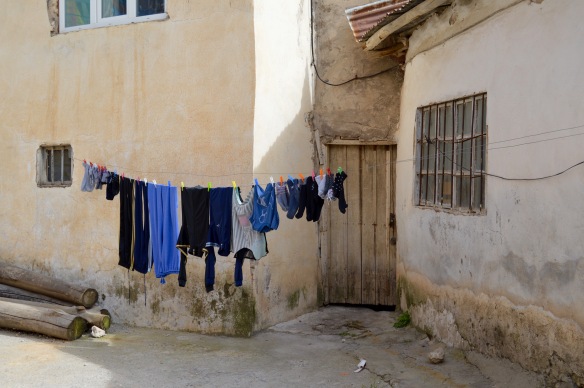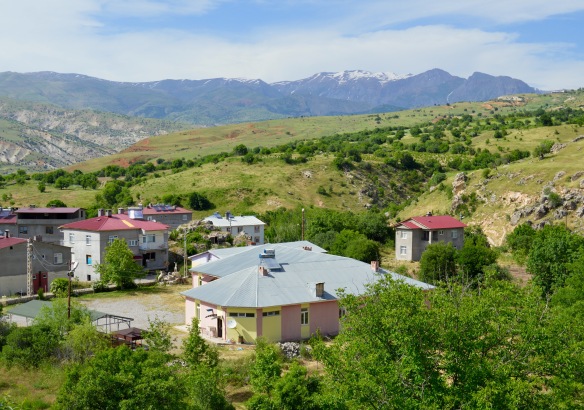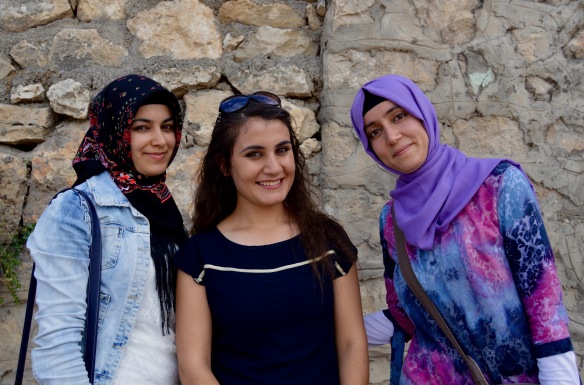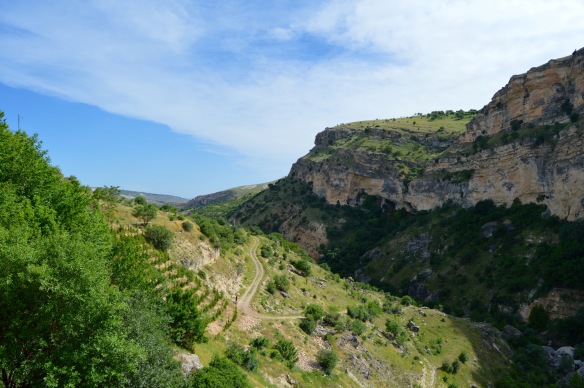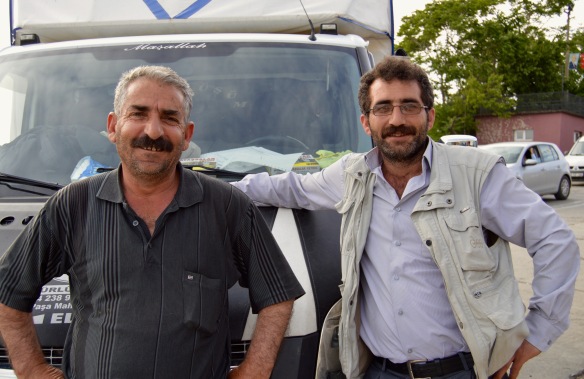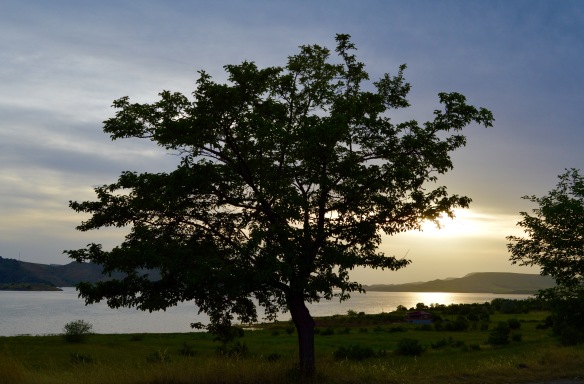Because of being dropped off where hills, a river, trees, pasture, wild flowers and lots of beehives presented an image of rural bliss, I decided to wait until a lift arrived and, after only 20 minutes, a small open-topped lorry drew to a halt. The driver already had two men in the cab and on the back of the lorry were two cows. I was lucky. The men and their cows were going to Cemisgezek. The two passengers shuffled along to make room for me and, just over an hour later, we arrived at our destination. While the driver said almost nothing the whole journey other than to reassure me that my presence was not a problem, the two passengers chattered incessantly in Zazaki, a language that I understood even less well than Kurmanji. I got the feeling they were gossiping about people they knew and about whether such people could be trusted when transacting business, because every so often sums of money were mentioned.
The journeys to and from Hozat and to and from the Armenian church had been remarkable, not least because the roads along which I travelled were usually high up so the views were extensive, but even more enjoyable was the journey to and from the junction where the lorry picked me up. When meandering along the valley floor, not once were we confined by a narrow gorge. The trees and small fields beside the rivers provided intimate counterpoint to the grandeur of the upland surroundings. However, a lot of time was spent high among rounded hills. The views were uninterrupted and took in distant mountains and the Keban Reservoir. There was pasture along the road and in the middle distance, and it sometimes covered the summits of the hills and mountains, but it was not quite as good as further north and east. Consequently, sheep and goats were more numerous than cattle and some of the flocks were enormous.
After about 40 kilometres of stunning upland scenery, we arrived in the centre of Cemisgezek, which lay above a river in a deep gorge with cliffs and mountains around it. By now it was 3.00pm and, when I explained that I had to return to Pertek that evening, the driver and his two companions expressed some alarm because minibuses did not travel the whole distance, only to the ferry a few kilometres to the south-east to take a short cut to Elazig. I felt confident I could hitch to my destination, but, to increase the chances of getting to Pertek before nightfall, I looked around the town for just over an hour.
Cemisgezek was large enough to have a vibrant commercial heart and a small pazar, the latter largely confined to a narrow street devoid of motorised traffic. Although modern structures of limited architectural merit outnumbered the old buildings, most of which were houses, enough of the latter survived to make the town a detour well worth undertaking (day trips from Elazig could be considered, given that minibuses ran most of the day. Cemisgezek did not seem to have a hotel worth staying in). Although some tooth-like rocks and a few traces of masonry revealed where the castle used to be high above the river in its gorge, other monuments from the past were of greater interest. Yelmaniye Camii dated from 1400. It had a portal with interesting carved ornamentation and a bright and attractive interior with a mihrab with a deep niche. Suleymaniye Camii had an impressive minaret dating from the Selcuk period. The town centre had two hamams. A turbe and a bridge, then latter with a single pointed arch, were in the nearby countryside.
Overlooking the town from the west were some caves in a cliff. One of the caves had some Armenian graffiti which Sinclair dates to the late 19th century. Sinclair also says that the caves were lived in until 1938 by Alevi Kurds who took part in “the Dersim revolt”. After a general pardon for prisoners, the Alevi Kurds who remained alive were given yaylas behind Yilan Dani “further up the valley of the Cemisgezek Su” and “enough money to buy flocks, even to build houses”.
While all the monuments just listed made a detour to Cemisgezek worthwhile, the old houses were the town’s most remarkable feature (however, the town seemed to be dominated by Alevis and everyone was very friendly, so this was another reason to visit a settlement a little off the beaten track). Many of the old houses survived as two-storey terraces along cobbled streets. The houses were timber-framed and the mudbrick walls were covered with render. People liked to paint the walls a rich variety of colours, some of which had attractive shades reminiscent of pastel crayons and ice cream. The narrower streets were overhung by the balconies of the upper storeys and the ground floors were sometimes a little below the level of the road.
I asked someone where the cemevi was located and was directed through the commercial heart of the town to a road leading to the north. The road ascended into an area that quickly became overwhelmingly residential. A few old stone houses survived, some of which spread over only one storey. I asked a woman for further directions and was urged to look down into a depression more or less constituting the northern extremity of Cemisgezek. I looked over a wall and saw a modern cemevi among some of the town’s newest houses. I was told it was called Kirklar Cemevi, or 40 Cemevi. For Alevis and Bektashis, the number 40 had special meaning. For some Alevis and Bektashis it referred to the 40 “saints” Muhammad is said to have encountered during his nocturnal ascent to heaven/paradise, and for others it referred to the 40 levels that applied to the four gates, or life stages, that made up the Alevi and Bektashi spiritual path (the path was usually identified by the Turkish word “yol”, a word commonly translated to mean “road”).
Because Cemisgezek had so much to enjoy, I stayed considerably longer than an hour. Just as I set off to walk out of the town to find somewhere from where to hitch a lift, I was stopped by three young women, all second year university students. We chatted a while and, although two of the women wore headscarves, photos had to be taken before I could resume my walk. Here were yet more friendly people, in this case female, and two were conventionally pious Sunni women willing to risk criticism for chatting with an unknown male. But Sunni women could get away with such unconventional behaviour in Dersim because gender equality and the empowerment of women were the norm. Such behaviour would be much less likely to manifest itself in Elazig or Erzincan.
I had walked about a half kilometre out of the town when a tractor stopped and the driver let me climb aboard for a lift of about 3 kilometres, which not only took me far beyond the last buildings of Cemisgezek, but also well into the delightful countryside to the south. I stood beside the road and five minutes later a man drove me to the northern edge of Akcapinar, the first village from Cemisgezek. By now, the sun was beginning its descent to the horizon. As a result, visibility was improving all the time. At the point I was dropped off, I looked down toward Akcapinar across gently undulating fields and pasture, and beyond the fields and pasture was the Keban Reservoir with water a deeper blue than at any point during the day. Hills and mountains dominated the distance.
About ten minutes later, a lorry drew to a halt and who should be in the cab but exactly the same three men who had driven me to Cemisgezek earlier in the day! I was surprised to see both cows were still on the back of the lorry, but it turned out that the men had been to Cemisgezek to undertake business that did not involve the livestock. Both cows were destined for one of the men’s small farms near Hozat.
Because the sun was behind us and the visibility very good, the journey to the junction for Hozat was even more enchanting than it had been when we drove to Cemisgezek. I identified about a dozen places where I wanted to stop, sometimes to take photos of the scenery alone and sometimes to take photos of shepherds and their large flocks of sheep and goats in their natural surroundings. A few unusual farm buildings were beside or not far from the road. When we finally arrived at the junction for Hozat, I wanted to give the driver some money for helping me fulfil most of the second part of the day’s programme, but he would not accept the notes in my hand. We were now friends even though we would probably never see each other again.
I walked a short way along the road toward Pertek, then saw to my right a small but ill-stocked supermarket occupying the ground floor of what was a large house or small apartment block. The building stood alone, but I could tell that the supermarket sold ice cream and beer. I called in for an ice cream and a chat with an elderly Alevi man who was the owner of the supermarket. The man was a retired guestworker who had made his money in Germany. He said that he owned the whole building and not just the supermarket.
I walked a little further along the road, then a lorry stopped and the driver and his companion offered me a lift all the way to the ferry that departed from near the Termal Hotel. Once again the scenery through which we passed looked delightful, especially as it was now about 6.00pm and the shadows were lengthening.
The two men in the cab were Kurdish Bektashis. It did not take long before discussion about the forthcoming election shifted to criticism of the Sunni majority in Turkey that had always oppressed Alevis and Bektashis. One of the men grew unusually animated as he described past injustices. His anger subsided only when we passed the turning for Dorutay where I was told that some turbes were pilgrimage sites for Alevis and Bektashis.
I stayed with the men until we arrived at the terminal because I wanted to take some photos of the castle and the ferry in the excellent early evening light, then I went to the hotel, showered and changed my clothes. I walked toward the roundabout with the large peace sign in the middle knowing that I would arrive at a small roadside bufe selling beer and snacks before I got there. I bought a beer and a packet of crisps. Along with a boiled egg saved from a breakfast in Tunceli two days earlier and a packet of salt left over from a THY meal at the start of the trip, this was all I could consume, given the excellent lunch and ice cream earlier in the day. On the way back from the bufe, the setting sun filled the sky with vibrant colours. I lined up some trees so they stood in silhouette in front of the reservoir and the multi-coloured sky before taking two photos. A little later, I walked beside the large jandarma post near the hotel so I could take photos of the castle from beside a small jetty. One of the men on guard duty in a tower overlooking the reservoir reminded me not to point the camera toward the jandarma post.
I examined the photographic results of a brilliant day’s adventures as I consumed my evening meal in my very comfortable bedroom. One thing I noticed was that there were not as many wild flowers as in the parts of Dersim visited the two previous days, but there were enough to make it worthwhile to arrange beehives on the hillsides and along the valley floors. At one point I had seen what proved to be the trip’s largest single collection of beehives in one place, a number far exceeding 100, and the beehives belonged to only three men.







